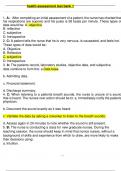Exam (elaborations)
Test bank for health assessment for nursing practice, 7th edition by wilson, all chapters 1 - 24, complete newest version
- Course
- Institution
Test bank for health assessment for nursing practice, 7th edition by wilson, all chapters 1 - 24, complete newest version
[Show more]



